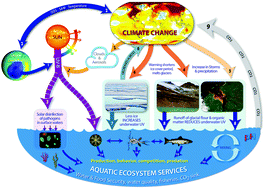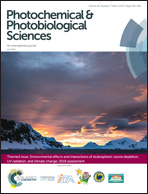The interactive effects of stratospheric ozone depletion, UV radiation, and climate change on aquatic ecosystems
Abstract
This assessment summarises the current state of knowledge on the interactive effects of ozone depletion and climate change on aquatic ecosystems, focusing on how these affect exposures to UV radiation in both inland and oceanic waters. The ways in which stratospheric ozone depletion is directly altering climate in the southern hemisphere and the consequent extensive effects on aquatic ecosystems are also addressed. The primary objective is to synthesise novel findings over the past four years in the context of the existing understanding of ecosystem response to UV radiation and the interactive effects of climate change. If it were not for the Montreal Protocol, stratospheric ozone depletion would have led to high levels of exposure to solar UV radiation with much stronger negative effects on all trophic levels in aquatic ecosystems than currently experienced in both inland and oceanic waters. This “world avoided” scenario that has curtailed ozone depletion, means that climate change and other environmental variables will play the primary role in regulating the exposure of aquatic organisms to solar UV radiation. Reductions in the thickness and duration of snow and ice cover are increasing the levels of exposure of aquatic organisms to UV radiation. Climate change was also expected to increase exposure by causing shallow mixed layers, but new data show deepening in some regions and shoaling in others. In contrast, climate-change related increases in heavy precipitation and melting of glaciers and permafrost are increasing the concentration and colour of UV-absorbing dissolved organic matter (DOM) and particulates. This is leading to the “browning” of many inland and coastal waters, with consequent loss of the valuable ecosystem service in which solar UV radiation disinfects surface waters of parasites and pathogens. Many organisms can reduce damage due to exposure to UV radiation through behavioural avoidance, photoprotection, and photoenzymatic repair, but meta-analyses continue to confirm negative effects of UV radiation across all trophic levels. Modeling studies estimating photoinhibition of primary production in parts of the Pacific Ocean have demonstrated that the UV radiation component of sunlight leads to a 20% decrease in estimates of primary productivity. Exposure to UV radiation can also lead to positive effects on some organisms by damaging less UV-tolerant predators, competitors, and pathogens. UV radiation also contributes to the formation of microplastic pollutants and interacts with artificial sunscreens and other pollutants with adverse effects on aquatic ecosystems. Exposure to UV-B radiation can decrease the toxicity of some pollutants such as methyl mercury (due to its role in demethylation) but increase the toxicity of other pollutants such as some pesticides and polycyclic aromatic hydrocarbons. Feeding on microplastics by zooplankton can lead to bioaccumulation in fish. Microplastics are found in up to 20% of fish marketed for human consumption, potentially threatening food security. Depletion of stratospheric ozone has altered climate in the southern hemisphere in ways that have increased oceanic productivity and consequently the growth, survival and reproduction of many sea birds and mammals. In contrast, warmer sea surface temperatures related to these climate shifts are also correlated with declines in both kelp beds in Tasmania and corals in Brazil. This assessment demonstrates that knowledge of the interactive effects of ozone depletion, UV radiation, and climate change factors on aquatic ecosystems has advanced considerably over the past four years and confirms the importance of considering synergies between environmental factors.

- This article is part of the themed collections: 2019 Perspective article collection and Environmental effects of ozone depletion and its interactions with climate change: 2018 Assessment


 Please wait while we load your content...
Please wait while we load your content...
